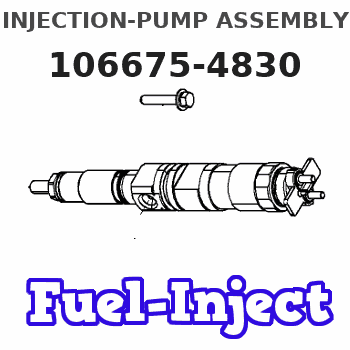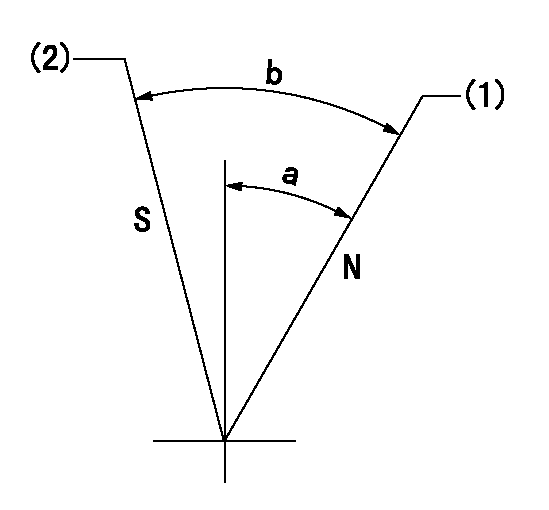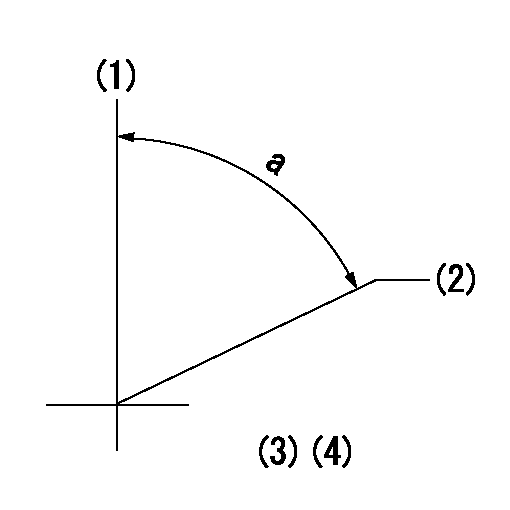Information injection-pump assembly
ZEXEL
106675-4830
1066754830

Rating:
Cross reference number
ZEXEL
106675-4830
1066754830
Zexel num
Bosch num
Firm num
Name
106675-4830
INJECTION-PUMP ASSEMBLY
Calibration Data:
Adjustment conditions
Test oil
1404 Test oil ISO4113 or {SAEJ967d}
1404 Test oil ISO4113 or {SAEJ967d}
Test oil temperature
degC
40
40
45
Nozzle and nozzle holder
105780-8140
Bosch type code
EF8511/9A
Nozzle
105780-0000
Bosch type code
DN12SD12T
Nozzle holder
105780-2080
Bosch type code
EF8511/9
Opening pressure
MPa
17.2
Opening pressure
kgf/cm2
175
Injection pipe
Outer diameter - inner diameter - length (mm) mm 8-3-600
Outer diameter - inner diameter - length (mm) mm 8-3-600
Overflow valve
131425-1620
Overflow valve opening pressure
kPa
255
221
289
Overflow valve opening pressure
kgf/cm2
2.6
2.25
2.95
Tester oil delivery pressure
kPa
255
255
255
Tester oil delivery pressure
kgf/cm2
2.6
2.6
2.6
RED3 control unit part number
407910-2
470
RED3 rack sensor specifications
mm
15
Direction of rotation (viewed from drive side)
Right R
Right R
Injection timing adjustment
Direction of rotation (viewed from drive side)
Right R
Right R
Injection order
1-5-3-6-
2-4
Pre-stroke
mm
4.5
4.45
4.55
Beginning of injection position
Drive side NO.1
Drive side NO.1
Difference between angles 1
Cal 1-5 deg. 60 59.5 60.5
Cal 1-5 deg. 60 59.5 60.5
Difference between angles 2
Cal 1-3 deg. 120 119.5 120.5
Cal 1-3 deg. 120 119.5 120.5
Difference between angles 3
Cal 1-6 deg. 180 179.5 180.5
Cal 1-6 deg. 180 179.5 180.5
Difference between angles 4
Cyl.1-2 deg. 240 239.5 240.5
Cyl.1-2 deg. 240 239.5 240.5
Difference between angles 5
Cal 1-4 deg. 300 299.5 300.5
Cal 1-4 deg. 300 299.5 300.5
Injection quantity adjustment
Rack position
(10.1)
Vist
V
1.98
1.98
1.98
Pump speed
r/min
900
900
900
Average injection quantity
mm3/st.
125.5
124
127
Max. variation between cylinders
%
0
-3
3
Basic
*
Injection quantity adjustment_02
Rack position
(6.6)
Vist
V
2.7
2.6
2.8
Pump speed
r/min
410
410
410
Average injection quantity
mm3/st.
12.5
11.3
13.7
Max. variation between cylinders
%
0
-15
15
Injection quantity adjustment_03
Remarks
Rack limit setting V = 0.9-0.04
Rack limit setting V = 0.9-0.04
Test data Ex:
Speed control lever angle

N:Pump normal
S:Stop the pump.
(1)Vist = aa, (rack position = bb)
(2)Rack position = cc
----------
aa=0.8V bb=16mm cc=1mm
----------
a=19deg+-5deg b=29deg+-5deg
----------
aa=0.8V bb=16mm cc=1mm
----------
a=19deg+-5deg b=29deg+-5deg
0000000901

(1)Pump vertical direction
(2)Position of camshaft's key groove at No 1 cylinder's beginning of injection
(3)-
(4)-
----------
----------
a=(60deg)
----------
----------
a=(60deg)
Stop lever angle

(Rs) rack sensor specifications
(C/U) control unit part number
(V) Rack sensor output voltage
(R) Rack position (mm)
1. Confirming governor output characteristics (rack 15 mm, span 6 mm)
(1)When the output voltages of the rack sensor are V1 and V2, check that the rack positions R1 and R2 in the table above are satisfied.
----------
----------
----------
----------
Information:
The electrical system is a combination of two separate electric circuits: The charging circuit and the starting circuit. Each circuit is dependent on some of the same components. The battery (batteries), on-off start switch, circuit breaker, ammeter, cables and wires from the battery are common in each of the circuits.
The ignition switch must be ON to allow the electrical system to function. Some charging circuit components will be damaged if the engine is operated with the ignition switch OFF.
The charging circuit is in operation when the diesel engine is operating. The electricity producing (charging) unit is an alternator. A regulator in the circuit senses the state of charge in the battery and regulates the alternator output to keep the batter fully charged.The alternator has four main components: end frame assembly (brush end), rotor assembly, stator and shell assembly, and end frame assembly (drive end).A separate regulator senses the charge condition of the battery as well as electrical system power demand and controls the alternator output accordingly by limiting the field current.
ALTERNATOR
Never operate the alternator without the battery in the circuit. Making or breaking an alternator connection with a heavy load on the circuit will sometimes result in regulator damage.
The starting motor is a device used to rotate the flywheel of an engine fast enough to start the engine.
ALTERNATOR REGULATOR
ELECTRIC STARTING MOTORThe starting motor includes a solenoid. The solenoid engages the pinion with the ring gear on the engine flywheel, when the solenoid is energized. The pinion always engages before the electric contacts in the solenoid causes the circuit between the battery and the starting motor to close. An overrunning clutch protects the starting motor from being overspeeded. Releasing the start-switch disengages the pinion and flywheel ring gear.A solenoid is a magnetic switch that uses low current to close a high current circuit. The solenoid is an electro-magnet with a movable core. There are contacts on the end of the core. The contacts are held apart by a spring pushing the core away from the magnetic center of the coil. Low current energizes the coil and forms a magnetic field. The magnetic field pulls the core to the center of the coil, closing the contacts and completing the starting circuit.
SOLENOID
The ignition switch must be ON to allow the electrical system to function. Some charging circuit components will be damaged if the engine is operated with the ignition switch OFF.
The charging circuit is in operation when the diesel engine is operating. The electricity producing (charging) unit is an alternator. A regulator in the circuit senses the state of charge in the battery and regulates the alternator output to keep the batter fully charged.The alternator has four main components: end frame assembly (brush end), rotor assembly, stator and shell assembly, and end frame assembly (drive end).A separate regulator senses the charge condition of the battery as well as electrical system power demand and controls the alternator output accordingly by limiting the field current.
ALTERNATOR
Never operate the alternator without the battery in the circuit. Making or breaking an alternator connection with a heavy load on the circuit will sometimes result in regulator damage.
The starting motor is a device used to rotate the flywheel of an engine fast enough to start the engine.
ALTERNATOR REGULATOR
ELECTRIC STARTING MOTORThe starting motor includes a solenoid. The solenoid engages the pinion with the ring gear on the engine flywheel, when the solenoid is energized. The pinion always engages before the electric contacts in the solenoid causes the circuit between the battery and the starting motor to close. An overrunning clutch protects the starting motor from being overspeeded. Releasing the start-switch disengages the pinion and flywheel ring gear.A solenoid is a magnetic switch that uses low current to close a high current circuit. The solenoid is an electro-magnet with a movable core. There are contacts on the end of the core. The contacts are held apart by a spring pushing the core away from the magnetic center of the coil. Low current energizes the coil and forms a magnetic field. The magnetic field pulls the core to the center of the coil, closing the contacts and completing the starting circuit.
SOLENOID
Have questions with 106675-4830?
Group cross 106675-4830 ZEXEL
Komatsu
Komatsu
106675-4830
INJECTION-PUMP ASSEMBLY